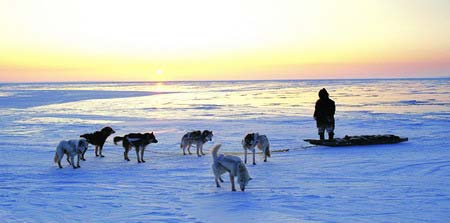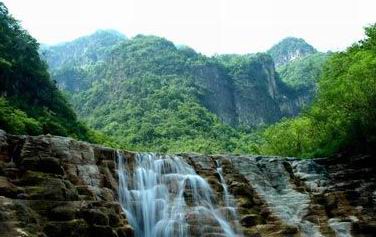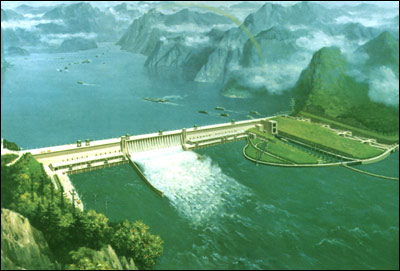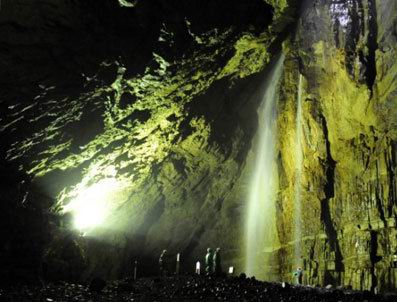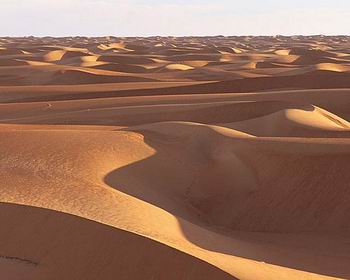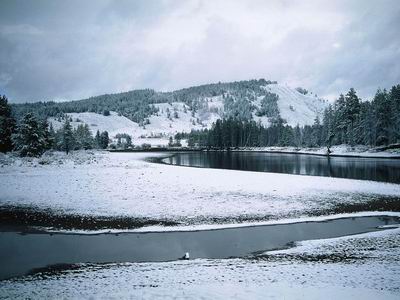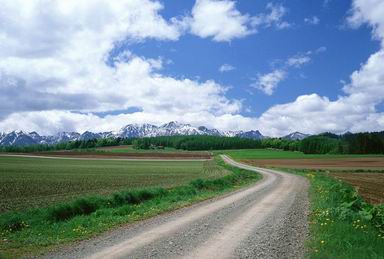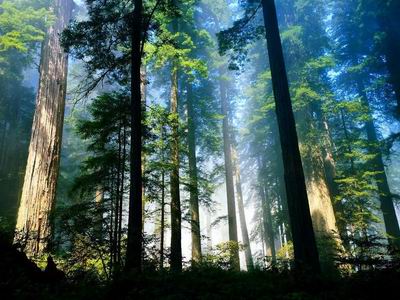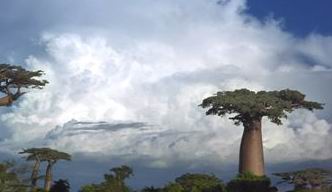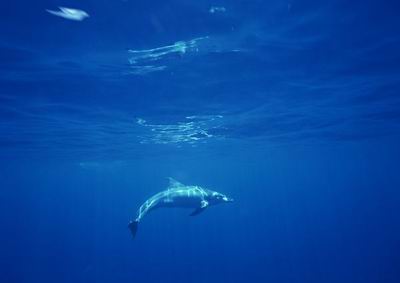(单词翻译:单击)
两极之间
两极之间 From Pole To Pole
What would the earth be like without the sun? We'll never know, but the emperor penguins come the nearest to that experience, as they suffer through winter in Antarctica, where temperatures can drop to minus 70 degrees centigrade. Meanwhile, the sun brightens the far north and the polar bears come out of hibernation. Spring in northern Canada means the migration of three million caribou across the arctic tundra. Winter in the deciduous forests of eastern Russia makes hunting difficult for the Amur leopard, the rarest cat in the world. On the island of New Guinea, birds have plenty of food, giving them time for elaborate mating rituals. "The sun influences life in the oceans just as it does on land," explains the narrator. We watch where the seals go to breed -- and we see the Great White sharks that follow them. What would the Earth be like without water? "Planet Earth" shows us where water is abundant and where it is scarce. During the dry season in the Kalahari desert, elephants go on an urgent search for water, which they find in Okavango. "The water brings a season of plenty for all animals." And that includes the wild dogs hunting impala. "Planet Earth" offers rare footage of the hunt; and in an afterword, we find how they got it.
我们永远不会知道,若没有太阳,地球将会如何?南极的帝企鹅却要在零下70摄氏度的低温中,度过漫漫6个月的冬天。而此时此刻,地球另一端的北极,新生的北极熊宝宝从冬眠的洞穴中钻出了脑袋。春天的到来带来了加拿大北部三百万头驯鹿的大迁徙。俄罗斯东部森林依旧白雪皑皑,珍稀的阿穆尔豹踪迹难觅。新几内亚小岛上,衣食无忧的天堂鸟华丽地展示羽毛,跳一出惊艳无比的求偶舞蹈。阳光不仅影响着陆地上的,也影响着大海中的生死存亡。海豹集中前去繁殖,引来大白鲨尾随而至,上演令人屏息静气的海上捕杀。除了阳光,还有水。大象徒步踏过喀拉哈里沙漠的旱季,最终到达洪水灌溉的奥卡万戈三角洲,一季泽国带来了物种的多样化,鬣狗高效地围追堵截羚羊。四季轮回,光阴不止。南极洲的帝企鹅,引来了六个月以来的第一缕阳光。
雄伟高山
雄伟高山 Mountains
Mountains are the most prominent products of the immense forces which shape the living planet: tectonic drift, volcanic activity and erosion by wind, water, frost and precipitation. We see how wildlife adapts to the harsh, often extreme conditions in various types of mountain ranges, such as Gelada baboons on a suddenly volcano-pushed Ethiopian peek, pumas in the Andes, grizzly bears in the Rockies, snow leopards in the Himalaya.
欢迎来到极端的、岩石与冰雪的世界。我们将踏上最雄伟的山脉的旅程——从于低洼处隆起的出于形成期的山脉直道珠穆朗玛峰的顶部,发现某些神秘的生物迎接高山生活的挑战而诞生,其中,我们还将看到一些最罕见的现象如熔岩湖。正是同样的力量创造了高山猿,同时还将看到狒狒群——一个有一千多名成员的大群落。在落基山脉,灰熊爬上峰顶大口的吞食夏季的蛀虫。同时,在另一个世界——巴基斯坦的山峰上,我们看到雪豹猎食的令人惊骇的一幕。
淡水资源
淡水资源 Freshwater
Although merely 3% of water on earth, fresh water plays an important part in the planet's weather and erosion. It is immensely important for all non-marine wildlife, which drinks fresh water and swims, procreates, hunts in it. Its concentrations, such as rivers, lakes and swamps, abound in aquatic and other species, often adapted to 'wet' life.
淡水是我们最宝贵的资源,它决定了地球上生命的分布。同河流一起,从高高的山峰一路而降,直向大海,观看壮观的瀑布,在大峡谷里飞翔,在世界上最深的湖泊的冰雪下面探索野生的生命,见证动物行为的独特的、生动的一面:水獭和泽鳄将一决胜负;善于深潜的短尾猿;振翅高飞的白天鹅;世界上最大的湿地的危险水域生活着的狂暴的水虎鱼……
洞穴迷宫
洞穴迷宫 Caves
The Earth's large, deep calcareous caves are virtually inaccessible and therefore barely explored - requiring expert diving where flooded. Some of its wildlife is as strange and specific as in the deep, darkest part of the ocean, whether physically adapted -notably to the dark. Nevertheless, some caves(did) play an important part in native cultures, even as sources of fresh water for some Mayan cities.
墨西哥的燕子洞立起来有400米深,足以放下整个帝国大厦;美国的龙舌兰洞穴系统有193米长,500米深,而且洞内悬挂着让人惊异的晶体结构。洞穴的神秘、不寻常之处通常不被注意,其实那儿同样生活着一些奇异的野生生物:洞穴天使鱼通过扁平的鳍上所生长的精微的钩状物使自己悬挂在洞穴瀑布后面的壁上;洞穴金丝燕通过声纳系统导航,用唾液建筑精美的巢;得克萨斯的洞穴火蜥蜴既没长眼睛也没有色素,让人惊奇的是它们怎样在这个到处都是钟乳石、石笋以及穴居生物的隐秘世界长期的生活着……
奇幻沙漠
奇幻沙漠 Desert
A large and growing part of earth's land mass is covered in desert - each one widely varied in composition and dryness. Wildlife species have adapted in different ways to these different arid lands especially to get and conserve water. Some are physically desert-models, like camels, others just changed their diet and behavior. Most live mainly at night, when it's cooler. The largest desert is northern Africa's Sahara, US size and extremely sandy, the result of grinding erosion of mountains. Short moist moments or periods are taken intense advantage off, leading to such extravaganzas as the locust swarm.
陆地的表面大约30%部分是沙漠,这些地区虽然严重缺水,生态系统却异常的多样。揭开沙漠地区的生存秘密,体验这种动态系统中短暂的自然本性;观看撒哈拉将近一英里高的沙暴;仅会存在一天的沙漠河流的蜿蜒;在戈壁滩中生存的大夏人骆驼会从雪中得到湿气;阿卡塔马沙漠中,骆马从仙人掌的脊背上舔舐露水;在美国的死亡谷,短暂的花期引发了65公里宽、160公里长的蝗虫群;飞跃纳米比亚沙漠的独特的航行向我们展示了大象为寻找食物而进行的长途跋涉;沙漠狮子在搜索着徘徊的羚羊……
冰封世界
冰封世界 Frozen
The polar caps have the most extreme seasonal contrasts, growing and melting vast ice masses, so wildlife adapts by annual migrations. The majority of Antartica is a vast barren permafrost. Only 3% of the coast and peninsular peaks are where life migrates to in the spring, for a short fertile summer, attracted by rich supplies of krill and fish. Only the Emperor penguin males breed 4 months in winter 100 miles inland. The Arctic has a more complete fauna which migrates back North from the continent. Here, the Polar bear is threatened because global warming defrosts its seal hunt platform ice too fast.
我们将跟随摄影机对处于最极端的季节的南极和北极作一次印象深刻的旅行,定时摄影机将对一群帝企鹅作仔细的观察,向我们展示帝企鹅行为中包含的动力学原理。独特的空中视角让我们看到了一幅清晰的的画面:由于全球变暖冰层融化,一只北极熊不得不游过一百公里,每次潜入水下两分钟之久,最后在筋疲力竭中去攻击一群海象。
辽阔平原
辽阔平原 Plains
A quarter of the earth's land mass, from arctic to tropical, are open plains consisting of lowland as well as highland plateaus. Here grows virtually indestructible, fast-growing grasses of all sizes that feed the planet's largest herbivore populations, the preys to solitary and social carnivores. Spectacular elements of the seasonal cycle of life can include mass migrations, monsoons, drought and great fires.
这里,你能亲眼目睹蒙古小羚羊的季节迁徙,这种机会相当难得。同时你不会错过第一次出现在摄影机镜头里的长相怪异的藏狐。历时六个星期,剧组为了跟踪一个企图捕杀大象的狮群,用夜视镜近距离地拍下了当时混战的场面。
富饶丛林
富饶丛林 Jungle
These environments occupy only 3% of the land yet are home to over half of the world's species. New Guinea is inhabited by almost 40 kinds of birds of paradise, which avoid conflict with each other by living in different parts of the island. Some of their elaborate courtship displays are shown. Within the dense forest canopy, sunlight is prized, and the death of a tree triggers a race by saplings to fill the vacant space. Figs are a widespread and popular food, and as many as 44 types of bird and monkey have been observed picking from a single tree.
热带雨林仅占据着地球3%的面积却生活着地球上50%的动植物,这是地球上最丰富的物种环境同时也是竞争最激烈的地方,在这里旅行你会惊异于这里的居民的神奇的生存方式。天堂鸟为求偶而翩翩起舞;所有的植物为了浓密丛林中的一丝阳光恣意生长……
多样浅海
多样浅海 Shallow Seas
Shallow seas cover only 8% of earth's surface, but contain the richest, most varied maritime life: from plankton and coral (literally vital for the very existence of reefs) to birds and from various invertebrates to mammals like seals, dolphins and whales and from sea snakes to countless fish species. Their ecological interaction is greatly varied and complex, often with nearby land to, even with deserts.
一头母座头鲸带着她的幼鲸开始了一场从热带天堂般的珊瑚海开始的远行,她们的目的地,是布满惊涛骇浪的极地大洋。这里有在印度尼西亚珊瑚海最新发现的矮小海马,闪着“电”光的蛤蜊和一丛丛的剧毒海蛇。这些海蛇每群30条之多,成群游弋捕食。这里还有海胆掉进巨海藻丛林,以及巨大的牛皮海狮捕食南非国王企鹅的场面。而这些企鹅不顾它们在体重上的劣势,拿出勇气与之海狮争斗的场景着实精彩。
季节森林
季节森林 Forest
Trees are earth's largest organisms and are also one of the planet's oldest inhabitants. Seasonal forests (unlike tropical rain-forest) the largest land habitats. A third of all trees grow in the endless taiga of the Arctic north. Northern America has forests that include California's sequoia's, the earth's largest trees. There and elsewhere, their vast production of photosynthesis and shade presides over a seasonal cycle of life and involves countless plant and animal species.
树木是地球最大的制氧机器,也是这个星球上最古老的居民。季节森林,比如我们熟悉的热带雨林,是陆地上生物最大的栖息地。泰加林的树木数量占据全球树木总量的三分之一;而北美森林中的加州水杉,是地球上最巨大的树木。这些林地光合作用为这个星球制造氧气,也同时为无数的动植物提供了生生不息的生存庇护。
无垠深海
无垠深海 Ocean Deep, Ocean Wide
Open ocean, a vast biotope covering two thirds of the planet, some shallow, some as deep as the mountain ranges are high. The ocean has an immense, precariously complex food chain, varying from microscopic animals, like krill, to whales, which ironically feed mainly on the former. Most species swim or float in it, many coming up for air, while other dive in from land or air, often to feed, but also to procreate on the coast, where some species come to lay their eggs. Even the shore is covered with life, largely based on organic matter, such as corpses.
你将看到30吨重的鲸鲨如何吃掉全部的鱼, 将从一个特别的高视角展示海豚是如何提速的。渐渐来到海洋深处, 你会看到长着"翅膀"的章鱼, 还会看到吸血鬼鱿鱼利用体内的发光体变换颜色。还有在2000米深处定时连续拍摄鳗鱼螃蟹类和高脚类动物个小时完全吃掉食物的镜头。

